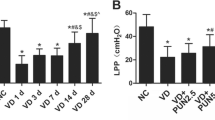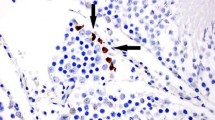Abstract
Purpose
The aim of the study was to evaluate the harmful effects of sepsis on the urogynecological tissues and the ability of Lacosamide (LCM) on Lipopolysaccharide (LPS)-induced cytokine production, oxidative stress and apoptotic pathways, in the experimental rat sepsis model.
Methods
Twenty-four female Wistar albino rats (12 months old) were divided into 3 groups as follows: control group (Group I) (0.1 ml/oral and i.p. saline, single dose), sepsis group (Group II) (5 mg/kg LPS, i.p. single dose) and sepsis + LCM group (Group III) (5 mg/kg LPS, i.p. single dose and 40 mg/kg LCM). Six hours after the last LPS administration, the animals were sacrificed. Subsequently, the analyses of urogenital tissues total oxidant/antioxidant status, histopathological and immunohistochemical analyses were performed.
Results
Total oxidant capacity (TOC) and oxidative stress index (OSI) values in the urogenital tissues were increased in the urogenital tissues in Group II [Total antioxidant capacity (TAC) was decreased] compared to group I (p < 0.05). LCM improved these values (p < 0.05). The immunohistochemical markers (Tumor Necrosis Factor-alpha (TNF-α), interleukin-1 beta (IL-1β), heat shock protein 70 (HSP-70), C-reactive protein (CRP), Malondialdehyde (MDA) were significantly increased in Group II (p < 0.001). With the administration of LCM (Group III), the expressions of above-mentioned markers were markedly decreased (p < 0.001). Marked hyperemia and slight hemorrhages with neutrophil leukocyte infiltrations were seen histopathologically in Group II. LCM treatment ameliorated the pathological findings.
Conclusion
These findings demonstrated that sepsis caused oxidative stress, apoptosis and inflammation in the urogenital tissues. We revealed that LCM ameliorated the damage caused by sepsis in urogenital tissue.







Similar content being viewed by others
References
Sakr Y, Jaschinski U, Wittebole X, Szakmany T, Lipman J, Ñamendys-Silva SA, Martin-Loeches I, Leone M, Lupu MN, Vincent JL (2018) ICON Investigators. Sepsis in ıntensive care unit patients: worldwide data from the ıntensive care over nations audit. Open Forum Infect Dis 5(12):313. https://doi.org/10.1093/ofid/ofy313 (eCollection 2018 Dec)
Chaudhry N, Duggal AK (2014) Sepsis associated encephalopathy. Adv Med 2014:762320. https://doi.org/10.1155/2014/762320
Fleischmann C, Scherag A, Adhikari NK, Hartog CS, Tsaganos T, Schlattmann P, Angus DC, Reinhart K (2016) International Forum of Acute Care Trialists. Assessment of global incidence and mortality of hospital-treated sepsis: current estimates and limitations. Am J Respir Crit Care Med 193:259–272. https://doi.org/10.1164/rccm.201504-0781OC
Mervyn S, Clifford SD, Christopher WS et al (2016) The third ınternational consensus definitions for sepsis and septic shock (Sepsis-3). JAMA 315:801–810. https://doi.org/10.1001/jama.2016.0287
De Backer D, Orbegozo Cortes D, Donadello K, Vincent JL (2014) Pathophysiology of microcirculatory dysfunction and the pathogenesis of septic shock. Virulence 5:73–79. https://doi.org/10.4161/viru.26482
Sener A, Sahbaz A, Sener LT, Tekkesin MS, Kaya B (2018) Effect of intraabdominally administered mesalazine (5-aminosalicylic acid) in experimental peritonitis. North Clin Istanb 5(3):171–175. https://doi.org/10.14744/nci.2017.48379
Shen HH, Huang SY, Cheng PY, Chu YJ, Chen SY, Lam KK, Lee YM (2017) Involvement of HSP70 and HO-1 in the the protective effects of raloxifene on multiple organdysfunction syndrome by endotoxemia in ovariectomized rats. Menopause 24(8):959–969. https://doi.org/10.1097/GME.0000000000000864
El-Awady MS, Nader MA, Sharawy MH (2017) The inhibition of inducible nitric oxide synthase and oxidative stress by agmatine attenuatesvascular dysfunction in rat acute endotoxemic model. Environ Toxicol Pharmacol 55:74–80. https://doi.org/10.1016/j.etap.2017.08.009
Annane D, Bellissant E, Cavaillon JM (2005) Septic shock. Lancet 365(9453):63–78. https://doi.org/10.1016/S0140-6736(04)17667-8
Hao JX, Stöhr T, Selve N, Wiesenfeld-Hallin Z, Xu XJ (2006) Lacosamide, a new anti-epileptic, alleviates neuropathic pain-like behaviors in rat models of spinal cord or trigeminal nerve injury. Eur J Pharmacol 553(1–3):135–140. https://doi.org/10.1016/j.ejphar.2006.09.040
Chung SS (2010) Lacosamide: new adjunctive treatment option for partial-onset seizures. Expert Opin Pharmacother 11(9):1595–1602. https://doi.org/10.1517/14656566.2010.488639
Willi Cawella (2015) Clinical Pharmacokinetic and Pharmacodynamic Profile of Lacosamide. Clin Pharmacokinet 54:901–914. https://doi.org/10.1007/s40262-015-0276-0
Cawello W, Stockis A, Andreas JO, Dimova S (2014) Advances in epilepsy treatment: lacosamide pharmacokinetic profile. Ann N Y Acad Sci 1329:18–32. https://doi.org/10.1111/nyas.12513
Erel O (2004) A novel automated direct measurement method for total antioxidant capacity using a new generation, more stable ABTS radical cation. Clin Biochem 37(4):277–285. https://doi.org/10.1016/j.clinbiochem.2003.11.015
Lorente L, Martín MM, Abreu-González P, Domínguez-Rodríguez A, Labarta L, Díaz C, Solé-Violán J, Ferreres J, Borreguero-León JM, Jiménez A, Morera-Fumero A (2013) Prognostic value of malondialdehyde serum levels in severe sepsis: a multicenter study. PLoS ONE 8(1):e53741. https://doi.org/10.1371/journal.pone.0053741
Aksoy AN, Toker A, Celık M, Aksoy M, Halıcı Z, Aksoy H (2014) The effect of progesterone on systemic inflammation and oxidative stress in the rat model of sepsis. Indian J Pharmacol 46:622–626. https://doi.org/10.4103/0253-7613.144922
Bitzer-Quintero OK, Dávalos-Marín AJ, Ortiz GG, Meza AR, Torres-Mendoza BM, Robles RG, Huerta VC, Beas-Zárate C (2010) Antioxidant activity of tryptophan in rats under experimental endotoxic shock. Biomed Pharmacother 64(1):77–81. https://doi.org/10.1016/j.biopha.2009.07.002
Solmaz V, Aksoy D, Yılmaz M, Eser E, Erbas O (2015) Demonstration of ameliorative effect of lacosamide: in a rat model of sepsis-induced critical illness polyneuropathy. Send to Neurol Res 37(9):797–802. https://doi.org/10.1179/1743132815Y.0000000040
Annagür A, Örs R, Altunhan H, Kurban S, Ertuğrul S, Konak M, Uygun SS, Pekcan S, Erbay E, Mehmetoğlu İ (2015) Total antioxidant and total oxidant states, and serum paraoxonase-1 in neonatal sepsis. Pediatr Int 57(4):608–613. https://doi.org/10.1111/ped.12557
Zeng Z, Chen Z, Li T, Zhang J, Gao Y, Xu S, Cai S, Zhao KS (2015) Polydatin: a new therapeutic agent against multiorgan dysfunction. J Surg Res 198:192–199. https://doi.org/10.1016/j.jss.2015.05.041
Lu ZQ, Lu JX, Deng YJ (2015) Glucocorticoids offer protection against myocardial injury in a murine model of sepsis. Int J Clin Exp Med 8(8):12211–12218 (eCollection 2015)
Bruemmer-Smith S, Stuber F, Schroeder S (2001) Protective functions of intracellular heat-shock protein (HSP) 70-expression in patients with severe sepsis. Intensive Care Med 27(12):1835–1841. https://doi.org/10.1007/s00134-001-1131-3
Briassoulis G, Briassouli E, Fitrolaki DM, Plati I, Apostolou K, Tavladaki T, Spanaki AM (2014) Heat shock protein 72 expressing stress in sepsis: unbridgeable gap between animal and human studies–a hypothetical ‘‘comparative” study. BioMed Res Int 2014:101023. https://doi.org/10.1155/2014/101023
Ilgun T, Dalginli KY, Gulmez C, Atakisi O (2016) Changes in the levels of liver HSP70, plasma nitric oxide, and the antioxidative system in an experimentally induced endotoxemia mouse model and the role of reduced glutathione. Turk J Biol 40:1272–1277. https://doi.org/10.3906/biy-1601-75
Gelain DP, de Bittencourt Pasquali MA, Comim CM, Grunwald MS, Ritter C, Tomasi CD, Alves SC, Quevedo J, Dal-Pizzol F, Moreira JC (2011) Serum heat shock protein 70 levels, oxidant status, and mortality in sepsis. Shock 35(5):466–470. https://doi.org/10.1097/SHK.0b013e31820fe704
Acknowledgements
The authors thank the participants who made this study possible.
Author information
Authors and Affiliations
Contributions
GI contributed to the literature search, project development, manuscript writing/editing, data collection and interpretation, experimental rat study, rat scarification and revision of the article; SM contributed to the biochemical analysis, statistical analysis, and rat sacrification; OO contributed to the histopathological and immunohistochemical analyses, management data analysis, and statistical analysis.
Corresponding author
Ethics declarations
Conflict of interest
All the authors declare that they have no conflict of interest.
Additional information
Publisher's Note
Springer Nature remains neutral with regard to jurisdictional claims in published maps and institutional affiliations.
Rights and permissions
About this article
Cite this article
Gunyeli, I., Saygin, M. & Ozmen, O. Overall systematic approach to sepsis damages on urogenital tissues: protective power of lacosamide. Arch Gynecol Obstet 300, 941–955 (2019). https://doi.org/10.1007/s00404-019-05262-1
Received:
Accepted:
Published:
Issue Date:
DOI: https://doi.org/10.1007/s00404-019-05262-1




